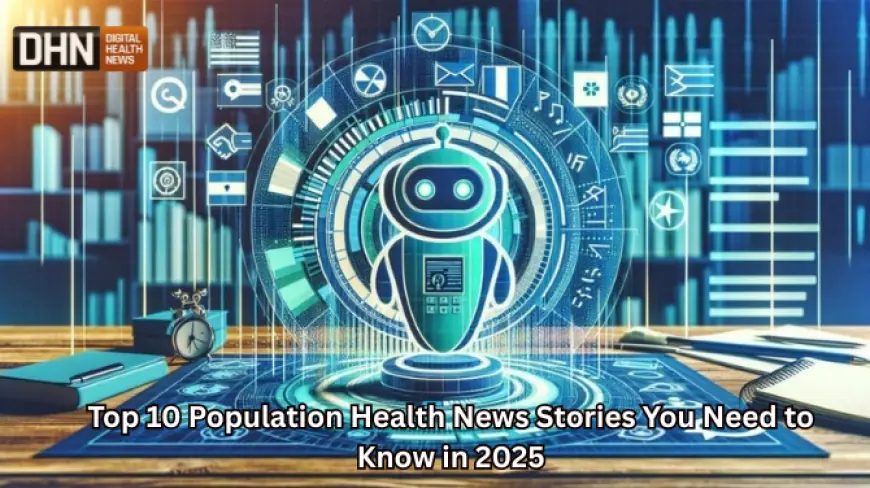Top 10 Population Health News Stories You Need to Know in 2025
Top 10 Population Health News Stories You Need to Know in 2025

In 2025, population health has taken center stage as healthcare systems across the globe face growing challenges—chronic disease management, aging populations, health equity, and the lasting effects of the COVID-19 pandemic. From AI-driven predictive analytics to groundbreaking policy shifts, this year’s top Population Health News stories reflect how innovation and collaboration are reshaping the future of public health.
Here are the top 10 Population Health News highlights of 2025 that you must know.
1. AI and Predictive Analytics Take the Lead in Preventive Care
One of the most significant stories in Population Health News is the widespread adoption of AI-powered tools in public health. Health systems are using predictive models to identify at-risk populations, forecast disease outbreaks, and personalize preventive strategies.
Companies like Google Health and Health Catalyst have launched platforms that help providers anticipate high-cost events and intervene early. This shift not only improves patient outcomes but also reduces healthcare spending.
2. Social Determinants of Health (SDOH) Get a Data-Driven Makeover
In 2025, addressing social determinants like housing, education, food insecurity, and transportation is no longer optional—it’s a necessity. New tools now integrate real-time SDOH data into electronic health records (EHRs), giving providers a more holistic view of patient well-being.
Partnerships between community organizations and healthcare providers are central to this trend, allowing healthcare teams to refer patients to local services with measurable results.
3. Remote Patient Monitoring (RPM) Expands Its Reach
Remote Patient Monitoring is a hot topic in Population Health News. RPM devices now track more than just heart rate and glucose levels—they’re monitoring mental health, sleep patterns, and medication adherence.
Health systems in the U.S., U.K., and India have reported a 30% decrease in hospital readmissions for chronic conditions like diabetes and hypertension, thanks to continuous RPM data. This marks a turning point in chronic disease management.
4. Health Equity Becomes a Strategic Priority
Equity is more than a buzzword in 2025—it's part of how success is measured. Health organizations are launching dashboards to track disparities in care outcomes, access, and satisfaction across demographics.
According to the CDC’s Population Health News bulletin, more than 150 U.S. hospitals now have Chief Health Equity Officers (CHEOs) to oversee equity-driven care initiatives.
5. Behavioral Health Integration Gains Momentum
Another standout in Population Health News this year is the growing integration of behavioral health into primary care. Mental health screenings are becoming a standard part of population health strategies, and platforms like Ginger and Talkspace are scaling to meet rising demand.
Payers are also expanding reimbursement for mental health RPM tools, encouraging adoption across rural and underserved areas.
6. Value-Based Care Models Go Mainstream
2025 marks a tipping point where fee-for-service is finally giving way to value-based population health management. Organizations are tying reimbursements to measurable improvements in patient outcomes.
Programs like CMS’s ACO REACH are showing how population health strategies reduce costs while improving care quality. This transition is expected to accelerate globally, particularly in Canada, the EU, and Southeast Asia.
7. Blockchain Enhances Health Data Transparency
Blockchain is emerging as a powerful tool in Population Health News. Blockchain-based health data exchanges are solving interoperability issues and giving patients control over their data.
Startups like MedBloc and Patientory are leading the charge, ensuring data accuracy while supporting real-time analytics for population health surveillance.
8. Climate Change and Public Health Collide
Extreme weather, air pollution, and climate-driven diseases are placing new demands on population health systems. 2025 has seen the launch of several initiatives aimed at integrating climate risk data into health planning.
Public health agencies now collaborate with environmental scientists to develop early warning systems for asthma attacks, heat strokes, and vector-borne illnesses—making climate-resilient care a top priority in this year’s Population Health News.
9. Telehealth 2.0 Redefines Access to Care
While telehealth surged during the pandemic, 2025 introduces Telehealth 2.0—a more personalized, AI-enhanced experience. This next-gen telemedicine is improving population health by reaching remote and underserved populations with diagnostics, counseling, and care plans in real time.
More than 80% of health systems now integrate telehealth into their population health strategy, expanding reach without compromising quality.
10. Population Health Education Gets an Upgrade
Recognizing a skills gap, academic institutions are updating curricula to include courses in population health analytics, health equity, and digital health tools.
In major Population Health News, top universities like Johns Hopkins, Harvard, and Oxford have launched new Master’s programs focused on population health innovation, preparing the next generation of healthcare leaders.
Final Thoughts
From technology to policy, the landscape of population health is transforming at a rapid pace. The Population Health News of 2025 reveals a strong shift toward proactive, tech-enabled, and equitable care systems. As stakeholders continue to embrace data, innovation, and collaboration, the future of population health looks more connected—and promising—than ever before.
What's Your Reaction?
 Like
0
Like
0
 Dislike
0
Dislike
0
 Love
0
Love
0
 Funny
0
Funny
0
 Angry
0
Angry
0
 Sad
0
Sad
0
 Wow
0
Wow
0



















































